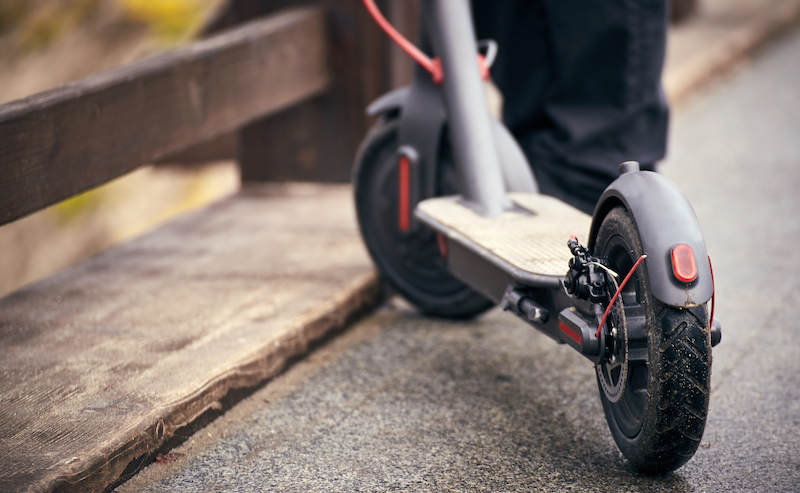
U.S. cities grapple with the regulatory challenges posed by electric scooter sharing programs.
Cities across the country have been invaded by flocks of Birds. But these Birds do not have wings—they have wheels.
Bird is the largest of several electric scooter share companies operating in cities worldwide. Scooter users download an app to locate and unlock the motorized scooters, then rent them by the minute. The scooters are dockless and tracked by GPS, so users can park them anywhere at the end of a ride instead of returning them to a designated location.
In theory, these programs are similar to bike shares like Indego, Divvy, and CitiBike, which offer short-term bicycle rentals within certain cities. But the sudden rollout of motorized scooters on city sidewalks—sometimes without warning—has demanded rapid regulatory responses from city officials.
In Los Angeles, where Bird unexpectedly launched last fall, many residents eagerly adopted motorized scooters as a short-distance transportation option. But the city government also received immediate complaints.
According to scooter share companies, users are supposed to ride scooters in bike lanes and park them near bike racks. But in practice, riders often zoom along sidewalks. Users also park scooters where they block pedestrian traffic, frustrating other residents.
Los Angeles issued a cease-and-desist letter to Bird in June 2018, demanding it to “remove any and all vehicles” from the city. But the letter also stated that the city had a “pending regulatory process for permitting scooters” which, if adopted, would allow Bird—and similar companies such as Lime and Spin—to operate scooter shares legally.
Since then, Los Angeles City Council approved a city-wide dockless vehicle pilot program. The program invited Bird and other companies to establish scooter shares by following new rules about permitting, parking, and maintenance. The regulations include a requirement for companies to have a 24-hour contact person available for “emergency removals” of scooters.
Other cities have also regulated scooters, including Washington, D.C. The city began a formal pilot program for dockless vehicles last year to test the popularity of scooter and bike shares. According to Washington’s Department of Transportation, the program logged more than 625,000 rides since its start date through June 2018.
Due to the high demand for dockless scooter and bike sharing, Washington extended its pilot program to the end of 2018 and plans to launch a new city-wide permitting process in 2019.
Despite their popularity, scooters do have their hazards. Broken bones, concussions, and other injuries have increased as more riders begin using scooters, sometimes with little or no experience. At least one scooter rider died after being struck by a car, raising concern about the safety of scooter users and pedestrians.
This is not the first time a novel transportation device has surprised regulators. The Segway, for instance, created similar issues when it first appeared in 2002. That two-wheeled device allowed users to ride standing up and facing forward—unlike a bicycle, motorcycle, or car—prompting a flurry of regulations governing how it could be used. But the Segway never gained widespread popularity, in part because of its high cost.
Electric scooters, by contrast, are more popular and affordable than the Segway. In most cities, Bird charges a dollar to unlock a scooter and only 15 cents per minute of riding. This makes scooters available to users who cannot or do not want to pay hundreds of dollars to purchase their own scooter. The widespread popularity of shared electric scooters has made calls for their regulation far more pressing than those raised by Segway.
Despite the scooter wave that has swept through cities worldwide, one major city has held out—New York City. This is in part because the state of New York completely prohibits the use of motorized scooters, defined as “a device with a motor attached and a handlebar for a standing rider.”
Scooter companies have so far been unwilling to launch in New York City. But growing demand for affordable, convenient transportation—and the potential to alleviate automobile traffic and parking challenges—has inspired city officials to pave the path for scooters. Two New York City Council members, Rafael L. Espinal Jr. and Ydanis Rodriguez, introduced a package of legislation that would allow electric scooter shares in the city. Espinal and Rodriguez reportedly said that scooter companies have been negotiating with city council “for months” and are “making a good-faith effort” to serve residents and fill an important transportation gap. But New York state law may still be a barrier.
Electric scooter sharing is now available worldwide, and scooter companies plan to continue expanding to new cities. Given the risks associated with this new transportation technology, smart regulatory action by city officials may be the key to bridging the interests between companies, cities, riders, and pedestrians.



